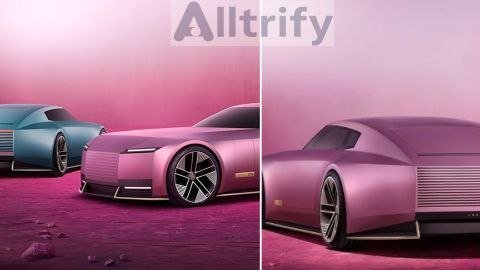Table of Contents
Introduction to Jaguar’s Rebranding Journey
Jaguar, a name traditionally associated with luxury and performance in the automotive industry, is currently undergoing a significant rebranding effort aimed at transitioning towards electric vehicles (EVs). This shift comes in response to evolving market demands and the growing emphasis on sustainability among consumers. However, the journey has not been entirely smooth. As Jaguar unveiled its ambitious plans to roll out its new lineup of EVs, the brand’s marketing campaign met with unexpected public backlash. Social media platforms became a battleground where the initial promotional material was subjected to ridicule and critique.
The challenges faced by Jaguar during this rebranding process highlight the complexities of evolving a storied brand. As the automotive landscape shifts towards greener alternatives, established names must navigate consumer perceptions while maintaining their legacy. The mocking tones on social media serve as a reminder of the skepticism that can greet brands attempting to reinvent themselves. While the ad campaign aimed to signal a new direction, it inadvertently sparked discussions that veered towards ridicule rather than excitement.
Despite these initial hurdles, the excitement surrounding Jaguar’s new electric vehicles remains palpable. The upcoming models promise to embody the same elegance and performance that have defined the brand for decades, infused with cutting-edge EV technology. This rebranding journey is not solely about overcoming negative perceptions; it also represents an opportunity for Jaguar to reclaim its position in the automotive market as a leader in innovation and sustainability. As the launch of these new EVs approaches, the focus will shift from initial mockery to the actual performance and design of the vehicles themselves, reflecting Jaguar’s commitment to moving forward in this transformative era.
The Ridicule: Social Media Reactions to the Ad Campaign
The launch of Jaguar’s latest advertising campaign aimed at promoting its new electric vehicles (EVs) was met with a wave of skepticism and ridicule across various social media platforms. While the campaign was intended to position Jaguar as a forward-thinking manufacturer in the evolving automotive landscape, the immediate public response highlighted a significant disconnect between the brand’s messaging and consumer expectations. Online reactions primarily manifested in the form of memes, parodies, and sarcastic commentary that quickly gained traction, effectively overshadowing the intended message of innovation and sustainability.
Many users took to platforms such as Twitter and Instagram to share humorous takes on the ads, with some memes poking fun at the stark comparison between Jaguar’s storied legacy of luxury sports cars and their new focus on electric vehicles. Such reactions demonstrated a broader concern among consumers regarding the authenticity of the brand’s shift towards electrification. Comments ranged from light-hearted jests to more pointed critiques that questioned whether Jaguar could truly reinvent itself in a market increasingly dominated by established players and emerging competitors in EV technology.
This kind of immediate backlash underscores the potential pitfalls that can accompany a rebranding effort, especially in an age where social media amplifies every consumer sentiment. It serves as a reminder that a well-crafted advertising strategy can be undermined by public interpretation and perception, often before a product has even been released. In examining the landscape of social media reactions, it becomes evident that Jaguar must navigate this robust discourse carefully, addressing the concerns and skepticism of its audience while working to solidify its new identity in the competitive EV market.
The Concept Car: A Glimpse into the Future
Jaguar has made a significant statement with the unveiling of its concept car, a stunning design that marries modern technology with nostalgia. Drawing inspiration from 1930s art deco aesthetics, this concept vehicle showcases several distinctive design elements, including a chopped top, butterfly doors, and an elongated hood. Each of these features reflects not only an artistic homage to its heritage but also a forward-thinking approach that underscores Jaguar’s commitment to innovative electric mobility.
The chopped top design enhances the vehicle’s aerodynamic efficiency while contributing to an unmistakably sleek profile. This feature serves both form and function, enabling a lower center of gravity which is essential for electric vehicle performance. Meanwhile, the butterfly doors, which open upward, provide a dramatic entrance while also facilitating easier access to the cabin, thus improving the overall user experience. This unique door design adds a layer of sophistication and modernity, distinguishing the concept from traditional automotive silhouettes.
The elongated hood is another remarkable feature, evoking a sense of grandeur typical of the luxury vehicles from the 1930s. It not only adds visual intrigue but also accommodates the advanced technology that lies beneath the surface. As Jaguar pivots towards electric vehicles, the concept car represents a pivotal shift in design philosophy; it is a harbinger of the elegant yet sustainable vehicles the brand plans to introduce in the coming years.
This concept serves as a visual statement of Jaguar’s future aspirations, merging their rich legacy with modern innovations. By embracing a blend of art deco inspiration and contemporary design elements, the brand positions itself not only as a designer of cars but as a pioneer in the electric vehicle market. Through this concept vehicle, Jaguar reinforces its commitment to delivering a remarkable driving experience while ensuring a sustainable future.
Transformations for Production: The Journey from Concept to Reality
The transition from concept to production for Jaguar’s new electric vehicles (EVs) has been marked by a series of critical developments that illustrate the challenges and triumphs inherent in automotive innovation. Initial concepts often spark excitement with their bold designs and futuristic technology; however, the realities of manufacturing necessitate adjustments that balance aesthetics with practicality. An exemplary modification in the evolution of Jaguar’s production EVs includes the addition of two extra doors, which significantly enhances accessibility and functionality for potential buyers.
The concept vehicle typically presents an alluring image, showcasing sleek lines and avant-garde features that capture the imagination of consumers and industry enthusiasts alike. However, as these vehicles move towards mass production, it becomes essential to consider real-world implications such as safety regulations, usability, and cost efficiency. Therefore, while many elements from the concept remain intact, certain decisions must be made to ensure that the final product meets the expectations of both the manufacturer and the buyer.
In addition to structural modifications, improvements in technology also play a significant role in the production phase. Adjustments may involve updates to the battery system, integration of advanced driver-assistance systems, and enhancements to in-car connectivity features. These factors ensure that the production vehicle not only retains its distinctive style but also provides a seamless driving experience that conjoins design and functionality. This careful balance reaffirms the essence of Jaguar’s initial vision while aiming to meet the demands of a rapidly evolving automotive landscape.
While the transformation from concept to production can be daunting, it ultimately helps to solidify Jaguar’s focus on creating remarkable electric vehicles. These changes demonstrate a commitment to excellence, fostering anticipation among consumers for a revamped automotive experience.
Innovative Design: The Jaguar Type 00 and its Unique Features
The Jaguar Type 00 stands as a testament to the brand’s commitment to innovation and luxury, manifesting a striking retro-futuristic design that sets it apart in the competitive luxury automobile market. This vehicle is not merely a car; it represents a significant shift in brand identity, encompassing both nostalgia and modernity. The design draws inspiration from Jaguar’s rich heritage, channeling elements from classic models while integrating contemporary aesthetics that appeal to today’s discerning customers.
The exterior of the Jaguar Type 00 features sleek lines and a streamlined silhouette, which evoke the essence of the original Jaguar designs. The incorporation of advanced materials and sustainable resources illustrates Jaguar’s dedication to eco-friendly practices without compromising luxury. Additionally, distinctive design elements such as elegant lighting fixtures and an innovative grille contribute to the vehicle’s charismatic appeal. This harmonious blend of past and future is not only visually engaging but also reinforces Jaguar’s commitment to the evolving demands of modern driving.
The unique design language of the Type 00 encapsulates the brand’s renewed vision, positioning it within an exclusive segment that prioritizes both performance and style. As Jaguar ventures into the electric vehicle (EV) market, the Type 00 embodies the convergence of sophisticated engineering with cutting-edge technology. Interior features, including advanced infotainment systems and luxurious seating materials, complement the exterior’s striking aesthetics, catering to the brand’s affluent clientele. With this model, Jaguar aims to cater to a new generation of consumers who value both sustainability and timeless elegance, ultimately redefining its image and market position.
Performance and Range: What Buyers Can Expect
Jaguar’s transition to electric vehicles (EVs) marks a significant shift in performance expectations for the brand. The new line of Jaguar EVs is designed with advanced dual-motor all-wheel drive systems, providing an exhilarating driving experience that merges power with precision. The implementation of dual motors not only enhances acceleration but also ensures superior traction and stability across a variety of driving conditions, making these vehicles suitable for a diverse range of consumers.
When it comes to range, Jaguar aims to impress with impressive metrics. For instance, many of the upcoming models are projected to offer an estimated range that meets or exceeds 300 miles on a single charge. Specific EPA ratings and WLTP metrics indicate that Jaguar is committed to delivering vehicles that compete robustly in the EV market. These figures not only showcase advancements in battery technology but also reflect Jaguar’s dedication to addressing consumer concerns regarding range anxiety, a common hesitation among potential EV buyers.
The battery capacity plays a crucial role in these performance specifications. Jaguar’s new EVs are equipped with high-capacity batteries that not only provide longer ranges but also contribute to faster charging times. With the integration of DC fast charging capabilities, these vehicles can achieve significant charge levels within a short span, allowing for greater convenience during travel. This is particularly significant for Jaguar’s target consumer market, which seeks not just luxury and performance but also the practicality and efficiency expected from modern electric mobility.
Overall, the latest Jaguar EVs promise a harmonious blend of performance and range, positioning the brand to appeal to both electric vehicle enthusiasts and traditional luxury car buyers. As Jaguar continues to innovate, the potential for redefining automotive experiences within the EV segment is vast, enabling buyers to anticipate a driving experience that meets their high expectations.
The Jaguar Electrified Architecture Framework
The Jaguar Electrified Architecture (JEA) represents a significant shift in the automotive landscape, specifically catered to the growing demand for electric vehicles (EVs). This bespoke platform is designed to effectively support the unique requirements of Jaguar’s future electric models, ensuring that they align with the brand’s long-standing reputation for performance and luxury. The JEA is poised to enhance the overall driving experience by integrating advanced technologies that optimize both performance and efficiency.
One of the standout features of the JEA is its potential incorporation of an 800-volt architecture. This innovative approach allows for faster charging times and improved efficiency when it comes to power delivery. With an 800-volt system, Jaguar can offer substantial benefits, such as reduced charging times at compatible stations, thereby minimizing downtime for drivers. The high voltage capabilities also facilitate reduced weight of electrical components and better overall energy management within the vehicle, amplifying its sustainability profile.
Moreover, the JEA is engineered with an emphasis on modularity, enabling Jaguar to produce a diverse range of electric vehicles while maintaining cost efficiencies. This versatility will allow Jaguar to cater to different market segments, from luxury sports cars to more accessible models, thus positioning the brand as a competitor in multiple classes within the electric vehicle market. The platform also supports advanced driver assistance systems and high-performance battery technologies, ensuring that future Jaguar models are equipped to meet consumer expectations for safety and technology.
In essence, the Jaguar Electrified Architecture will not only define the next generation of Jaguar vehicles but also enhance the manufacturer’s competitiveness in the rapidly evolving EV market. By adopting this innovative framework, Jaguar is poised to lead the way in delivering luxurious, efficient, and high-performing electric vehicles that resonate with new generations of car buyers.
Pricing Strategy and Market Positioning
Jaguar’s rebranding efforts to embrace electric vehicles (EVs) have led to a crucial focus on pricing strategy and market positioning. As the automotive market shifts towards sustainability, the pricing of Jaguar’s new electric fastback will play a significant role in determining its competitive advantage. The anticipated base price for the new fastback is expected to align closely with Jaguar’s existing lineup, specifically aiming to attract buyers accustomed to the luxury car market. A price range that resonates with their past models could allow Jaguar to maintain brand loyalty while appealing to new clients interested in EV technology.
Additionally, Jaguar’s strategic consideration of future pricing for its electric crossover models is essential. By positioning these vehicles at competitive price points, Jaguar can capture a wider audience, particularly among consumers who may prioritize affordability alongside advanced technology. The pricing strategies will likely incorporate variations based on features, battery specifications, and performance capabilities, ensuring that each model reflects the brand’s luxurious heritage while appealing to modern-day environmental considerations.
The targeted consumer demographic for Jaguar’s new EV lineup appears to be a blend of existing luxury car enthusiasts and those newly interested in high-performance electric vehicles. This dual focus will necessitate a pricing structure that not only retains current customers but also invites prospective buyers seeking modern alternatives to traditional combustion-engine vehicles. As Jaguar navigates this transition, keeping an eye on competitor pricing will be vital in solidifying its market position. The balancing act between luxury perception and price competitiveness will ultimately define Jaguar’s success in this evolving automotive landscape.
Redefining Customer Experience: The Jaguar House Concept
In an effort to transform the luxury car buying experience, Jaguar has introduced the Jaguar House concept, a radical departure from traditional dealerships. Located in key cities, these boutique showrooms are designed to provide a unique and immersive environment where customers can engage with the brand. Unlike standard car dealerships that may overwhelm potential buyers with rows of vehicles, the Jaguar House prioritizes a serene atmosphere. This innovative approach allows for a more personalized interaction with the brand, setting the stage for a memorable car-buying journey.
The layout of a Jaguar House is reminiscent of a high-end retail space, emphasizing elegance and exclusivity. Each boutique is meticulously designed to reflect the brand’s heritage and craftsmanship, showcasing not just vehicles but also aspects of the Jaguar lifestyle. Customers can explore the latest electric vehicles (EVs) in a relaxed setting, often accompanied by customized consultations that cater to individual preferences. This level of service aims to rival offerings from luxury brands such as Rolls Royce and Bentley, ensuring that every interaction feels special and informative.
Moreover, the Jaguar House redefines the traditional sales process by prioritizing experience over transaction. Customers are invited to participate in tailored experiences, such as test drives that blend scenic routes with an opportunity to explore the car’s features in depth. This forward-thinking model shifts the focus from merely selling cars to fostering long-lasting relationships with customers. By enhancing the experiential dimension of car buying, Jaguar aims to bridge the gap between automotive excellence and luxury lifestyle, positioning itself as a formidable competitor in the luxury EV market.





